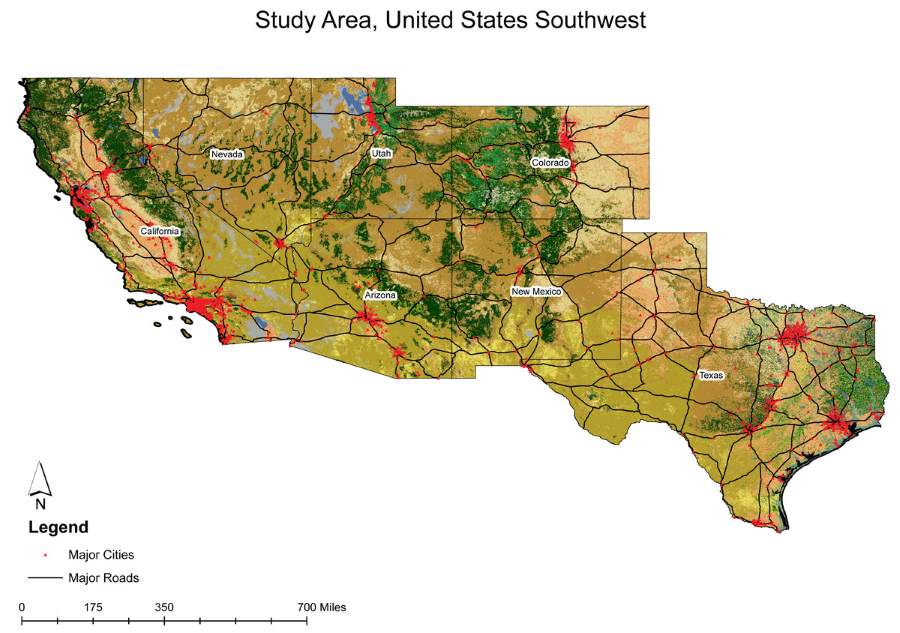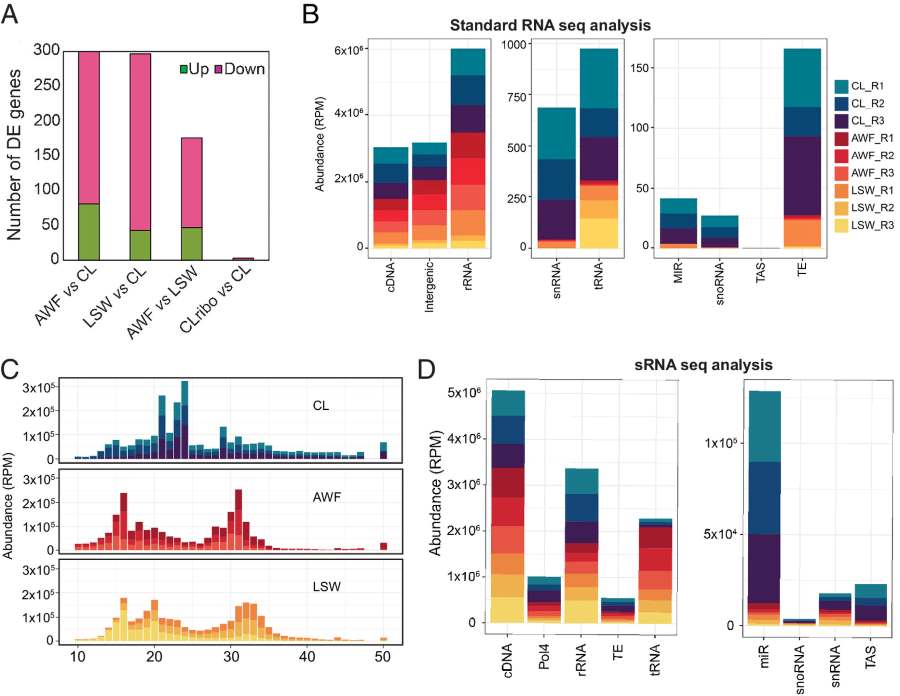Discover the latest articles from leading science journals in the Muser Press weekly roundup, showcasing impactful studies published this week.
Balancing renewable energy expansion and biodiversity conservation: new research highlights overlap of solar energy potential and critical habitats in the Southwest
PeerJ – As the climate crisis accelerates, the urgent transition to renewable energy sources is at the forefront of global sustainability efforts. However, a new study by Ms. Kylee Fleckenstein, published in PeerJ Life & Environment, reveals a critical challenge in balancing renewable energy development with biodiversity conservation inthe arid Southwest United States.
The research, titled ‘Mapping species of greatest conservation need and solar energy potential in the arid Southwest for future sustainable development’, explores the intersection of high-priority conservationhabitats and areas suitable for large-scale Solar Energy Development (SED).

With its abundant sunshine and open landscapes, the Southwest boasts some of thehighest Global Horizontal Irradiance (GHI) values in the country, making it a prime location for solar energy expansion.
However, the region is also home to unique and vulnerable species, including the LeConte’s Thrasher (Toxostoma lecontei), Bendire’s Thrasher (Toxostoma bendirei), Sonoran Desert Tortoise (Gopherus morafkai), Mojave Desert Tortoise (Gopherus agassizii), and the Southwestern population of the Burrowing Owl (Athene cunicularia).
Ms. Fleckenstein’s study uses a novel combined approach, employing Species Distribution Modeling (SDM) to map areas of likely species presence and high habitat suitability, alongside a site suitability analysis for potential solar development sites. The findings indicate a significant overlap between high-priority habitats and optimal locations for SED, underscoring the urgent need for strategies that balance renewable energy growth with conservation priorities.
“Our study highlights a paradox: the same landscapes that make the Southwest ideal for solar energy development are also critical for the survival of species that are already facing threats from habitat loss, population growth, and climate change,” said Ms. Fleckenstein. “This research offers a roadmap for identifying areas where development can proceed sustainably, minimizing impacts on biodiversity.”
The study provides actionable insights for policymakers, conservationists, and developers, emphasizing the importance of integrating biodiversity conservation into renewable energy planning. By identifying areas of overlap between conservation priorities and energy potential, stakeholders can make informed decisions to support both sustainable development and the protection of the region’s unique ecological heritage.
As the U.S. prepares to scale up renewable energy initiatives, particularly solar energy projects, the study calls for a collaborative approach to ensure that renewable energy solutions do not come at the cost of irreplaceable biodiversity.
Key Findings:
- Significant overlap exists between optimal solar development locations and critical habitats for several vulnerable species.
- Species distribution modeling (SDM) and site suitability analysis offer effective tools for aligning energy development with conservation priorities.
- A coordinated, science-based approach is crucial for mitigating the impacts of solar energy projects on sensitive ecosystems.
This research serves as a call to action for a balanced approach to climate solutions, ensuring that the shift to renewable energy is not only sustainable but also responsible.
Journal Reference:
Kylee Fleckenstein, Adam Stein, Heather L. Bateman, Fabio De Albuquerque, ‘Mapping species of greatest conservation need and solar energy potential in the arid Southwest for future sustainable development’, PeerJ Life & Environment 13:e18568 (2025). DOI: 10.7717/peerj.18568
Source: PeerJ
New study suggests RNA present on surfaces of leaves may shape microbial communities
Indiana University – Biologists at Indiana University Bloomington have shown that the surfaces of plant leaves are coated with a diverse array of RNA molecules. The finding suggests that the RNA present on the leaf surface may play a role in shaping the microbial communities that inhabit them, potentially influencing plant health and interactions within their environment, according to a new study.
The study, ‘Diverse plant RNAs coat Arabidopsis leaves and are distinct from apoplastic RNAs’, was published in the Proceedings of the National Academy of Sciences.
The first authors are Lucía Borniego and Meenu Singla-Rastogi, postdoctoral fellows at the Indiana University Department of Biology in the College of Arts and Sciences. The senior author is Roger Innes, Distinguished Professor of Biology.

“What excites us most about this discovery is that it indicates plants may control their microbiomes, in part, by regulating gene expression in microbes using cross-kingdom RNA interference, also known as RNAi,” said Innes. “RNA interference is a well-known type of gene regulation in which cells can turn down the expression of a gene by expressing a small RNA that can base pair with the RNA of the target gene. This type of gene regulation appears to occur in just about all living organisms, but only recently has it been shown that RNAs produced by one organism can be taken by another organism and then base pair with RNAs in the recipient organism.”
RNA is extremely fragile, and thus rapidly broken down if it is not protected. The study produces some of the first evidence that plants can secrete viable RNA onto the surfaces of their leaves.
The paper found there are abundant RNAs on leaf surfaces that are surprisingly stable. Data presented in the paper suggests that this stability might be associated with the ability of the RNA to form condensates with polysaccharides, such as pectin.
By discovering that plant leaves are coated with RNA, this work shows that the microbes that colonize the surfaces of leaves are exposed to plant RNA and likely interact with this RNA. In turn, this likely impacts gene expression in these microbes, which could impact which microbes thrive on the leaves’ surfaces.
“The manipulation of microbial communities by environmental RNA is likely taking place in our own guts as well, with RNA being secreted by our intestinal epithelial cells,” said Innes. “It is also quite possible that RNA on leaf surfaces, like salad, could influence our own gut microbiomes.”
Additional contributors to the paper were Megha Hastantram Sampangi-Ramaiah and Hana Zand Karimi of the Indiana University Department of Biology, Patricia Baldrich and Blake C. Meyers of University of California – Davis, and Madison McGregor of the Donald Danforth Plant Science Center.
Journal Reference:
M.L. Borniego, M. Singla-Rastogi, P. Baldrich, M.H. Sampangi-Ramaiah, H. Zand Karimi, M. McGregor, B.C. Meyers, R.W. Innes, ‘Diverse plant RNAs coat Arabidopsis leaves and are distinct from apoplastic RNAs’, Proceedings of the National Academy of Sciences 122 (1) e2409090121 (2025). DOI: 10.1073/pnas.2409090121
Source: Indiana University
Other science articles published this week
The proteome is a terminal electron acceptor
A.I. Flamholz, A. Goyal, W.W. Fischer, D.K. Newman, R. Phillips (2025) | Proceedings of the National Academy of Sciences | DOI: 10.1073/pnas.2404048121
Beyond despair: Leveraging ecosystem restoration for psychosocial resilience
C.S. Smith, E.A. DeMattia, E. Albright, A.F. Bromberger, O.G. Hayward, I.J. Mackinson, S.A. Mantell, B.G. McAdoo, D. McAfee, A. McCollum, A.B. Paxton, A. Roderer, K. Stevenson, R.L. Vidra, Z. Zhao (2025) | Proceedings of the National Academy of Sciences | DOI: 10.1073/pnas.2307082121
Intersectionality in youth climate activism as educational practice: political, pragmatic, and pedagogical dimensions
Garcia A, Rebelo D, Diógenes-Lima J, Fernandes-Jesus M and Malafaia C (2025) | Frontiers in Education | DOI: 10.3389/feduc.2024.1491387
Burden trends and future predictions for hypertensive heart disease attributable to non-optimal temperatures in the older adults amidst climate change, 1990–2021
Xu C, Nie X, Xu R, Han G and Wang D (2025) | Frontiers in Public Health | DOI: 10.3389/fpubh.2024.1525357
Novel climate analysis methods applied to the Australian ESCI projections data
Dowdy A and King A (2025) | Frontiers in Climate | DOI: 10.3389/fclim.2024.1492228
Large-scale drivers of widespread extreme precipitation in Europe: insights from high-resolution regional climate model simulations
Namendra Kumar Shahi, Olga Zolina, and Sergey K. Gulev (2025) | Journal of Hydrometeorology | DOI: 10.1175/JHM-D-24-0035.1
China’s Natural Runoff Record: A High-Quality Dataset for Hydrological and Climate Studies
Jiaojiao Gou, Chiyuan Miao, Luis Samaniego, Mu Xiao, Jingwen Wu, and Xiaoying Guo (2025) | Bulletin of the American Meteorological Society | DOI: 10.1175/BAMS-D-20-0094.A
Projected Effects of Climate Change on Meteorological Droughts over China: A Study Based on High-Resolution NEX-GDDP Data
Fuqiang Cao, Xiaoyu Long, Tao Gao, Ming Li, Junjie Zhan, and Ming Zhou (2025) | Journal of Hydrometeorology | DOI: 10.1175/JHM-D-23-0178.1
Transient climate sensitivity shaped by low cloud changes remotely driven by Southern Ocean processes
Robert R. Ford, Brian E. J. Rose, and M. Cameron Rencurrel (2025) | Journal of Climate | DOI: 10.1175/JCLI-D-24-0164.1
Time–Frequency Spillovers and Connectedness between Chinese Climate Risk Perception and Energy Markets
Zhiming Yang, Yiru Wang, Xiang Li, Jing Li, Lifu Fu, and Lei Qiao (2025) | Weather, Climate, and Society | DOI: 10.1175/WCAS-D-24-0005.1
Effects of long-term fertilizer practices on rhizosphere soil ammonia oxidizer community structure under the double-cropping rice field
Tang, H., Wen, L., Shi, L. et al. (2025) | Scientific Reports | DOI: 10.1038/s41598-025-85289-4
The optimum nitrogen fertilizer rate for maize in the US Midwest is increasing
Baum, M.E., Sawyer, J.E., Nafziger, E.D. et al. (2025) | Nature Communications | DOI: 10.1038/s41467-024-55314-7
Defect identification of fan blade based on adaptive parameter region growth algorithm
Yifan, W., Xueyao, W., Dongmei, Y. et al. (2025) | Scientific Reports | DOI: 10.1038/s41598-024-85031-6
Integrated approach for estimating climate change impacts on CO2 sink capacity of inland waterbodies using hydrodynamic modelling and GIS analysis
Khalil, H.H., Abdrabo, M.A., Hassaan, M.A. et al. (2025) | Scientific Reports | DOI: 10.1038/s41598-024-81707-1
Continental drift triggered the Early Permian aridification of North China
Ren, Q., Zhang, S., Hou, M. et al. (2025) | Nature Communications | DOI: 10.1038/s41467-024-55804-8
Improved estimation of carbon dioxide and methane using machine learning with satellite observations over the Arabian Peninsula
Alcibahy, M., Gafoor, F.A., Mustafa, F. et al. (2025) | Scientific Reports | DOI: 10.1038/s41598-024-84593-9
The global implications of a Russian gas pivot to Asia
Pye, S., Bradshaw, M., Price, J. et al. (2025) | Nature Communications | DOI: 10.1038/s41467-024-55697-7
Scaling deep at the margins: coproduction of nature-based solutions as decolonial research praxis in Cape Town
Mguni, P., Herslund, L.B., Abrams, A.L. et al. (2025) | npj Urban Sustainability | DOI: 10.1038/s42949-024-00190-9
Effects of urban sprawl due to migration on spatiotemporal land use-land cover change: a case study of Bartın in Türkiye
Şen, G. (2025) | Scientific Reports | DOI: 10.1038/s41598-025-85353-z
Quantitative risk assessment of rainstorm-induced flood disaster in Piedmont plain of Pakistan
Chang, M., Zhou, K., Dou, X. et al. (2025) | Scientific Reports | DOI: 10.1038/s41598-024-84738-w
An integrated DEA-fuzzy AHP method for prioritization of renewable energy sources in India
Luhaniwal, J., Agarwal, S. & Mathur, T. (2025) | Scientific Reports | DOI: 10.1038/s41598-024-84891-2
A New Global Mangrove Height Map with a 12 meter spatial resolution
Simard, M., Fatoyinbo, L., Thomas, N.M. et al. (2025) | Scientific Data | DOI: 10.1038/s41597-024-04213-z
Using transformer-based models and social media posts for heat stroke detection
Anno, S., Kimura, Y. & Sugita, S. (2025) | Scientific Reports | DOI: 10.1038/s41598-024-84992-y
Risk-based bridge life cycle cost and environmental impact assessment considering climate change effects
Lee, S.H., An, LS. & Kim, HK. (2025) | Scientific Reports | DOI: 10.1038/s41598-024-82568-4
Tropical cyclone risk for global ecosystems in a changing climate
Kropf, C.M., Vaterlaus, L., Bresch, D.N. et al. (2025) | Nature Climate Change | DOI: 10.1038/s41558-024-02194-w
Agricultural subsoil microbiomes and functions exhibit lower resistance to global change than topsoils in Chinese agroecosystems
Peng, Z., van der Heijden, M.G.A., Liu, Y. et al. (2025) | Nature Food | DOI: 10.1038/s43016-024-01106-7
Estimating pros and cons of statistical downscaling based on EQM bias adjustment as a complementary method to dynamical downscaling
Reder, A., Fedele, G., Manco, I. et al. (2025) | Scientific Reports | DOI: 10.1038/s41598-024-84527-5
Energy and socioeconomic system transformation through a decade of IPCC-assessed scenarios
van de Ven, D.J., Mittal, S., Nikas, A. et al. (2025) | Nature Climate Change | DOI: 10.1038/s41558-024-02198-6
Predictability of abrupt shifts in dryland ecosystem functioning
Bernardino, P.N., De Keersmaecker, W., Horion, S. et al. (2025) | Nature Climate Change | DOI: 10.1038/s41558-024-02201-0
Limited decrease of Southern Ocean sulfur productivity across the penultimate termination
Fischer, H., Burke, A., Rae, J. et al. (2025) | Nature Geoscience | DOI: 10.1038/s41561-024-01619-7
Does Artificial Intelligence (AI) enhance green economy efficiency? The role of green finance, trade openness, and R&D investment
Wang, Q., Sun, T. & Li, R. (2025) | Humanities and Social Sciences Communications | DOI: 10.1057/s41599-024-04319-0
Preservation of organic carbon in marine sediments sustained by sorption and transformation processes
Babakhani, P., Dale, A.W., Woulds, C. et al. (2025) | Nature Geoscience | DOI: 10.1038/s41561-024-01606-y
Downscaling of ERA5 reanalysis land surface temperature based on attention mechanism and Google Earth Engine
Li, S., Wan, H., Yu, Q. et al. (2025) | Scientific Reports | DOI: 10.1038/s41598-024-83944-w
Substantial and overlooked greenhouse gas emissions from deep Arctic lake sediment
Freitas, N.L., Walter Anthony, K., Lenz, J. et al. (2025) | Nature Geoscience | DOI: 10.1038/s41561-024-01614-y
Perennial disaster patterns in Central Europe since 2000 and implications for hospital preparedness planning – a cross-sectional analysis
von der Forst, M., Dietrich, M., Schmitt, F.C.F. et al. (2025) | Scientific Reports | DOI: 10.1038/s41598-024-84223-4
Urban growth strategy in Greater Sydney leads to unintended social and environmental challenges
Ríos-Ocampo, J.P., Gary, M.S. (2025) | Nature Cities | DOI: 10.1038/s44284-024-00187-6
Large floods drive changes in cause-specific mortality in the United States
Lynch, V.D., Sullivan, J.A., Flores, A.B. et al. (2025) | Nature Medicine | DOI: 10.1038/s41591-024-03358-z
Genome-wide association studies in lettuce reveal the interplay of seed age, color, and germination under high temperatures
Oh, S., Ahn, E., Shi, A. et al. (2025) | Scientific Reports | DOI: 10.1038/s41598-024-84197-3
Relating satellite NO2 tropospheric columns to near-surface concentrations: implications from ground-based MAX-DOAS NO2 vertical profile observations
Chang, B., Liu, H., Zhang, C. et al. (2025) | npj Climate and Atmospheric Science | DOI: 10.1038/s41612-024-00891-z
Green finance instruments and empowering sustainability in East Asian economies
Shi, Y., Yang, B. (2025) | Humanities and Social Sciences Communications | DOI: 10.1057/s41599-024-04324-3
Featured image credit: kjpargeter | Freepik




